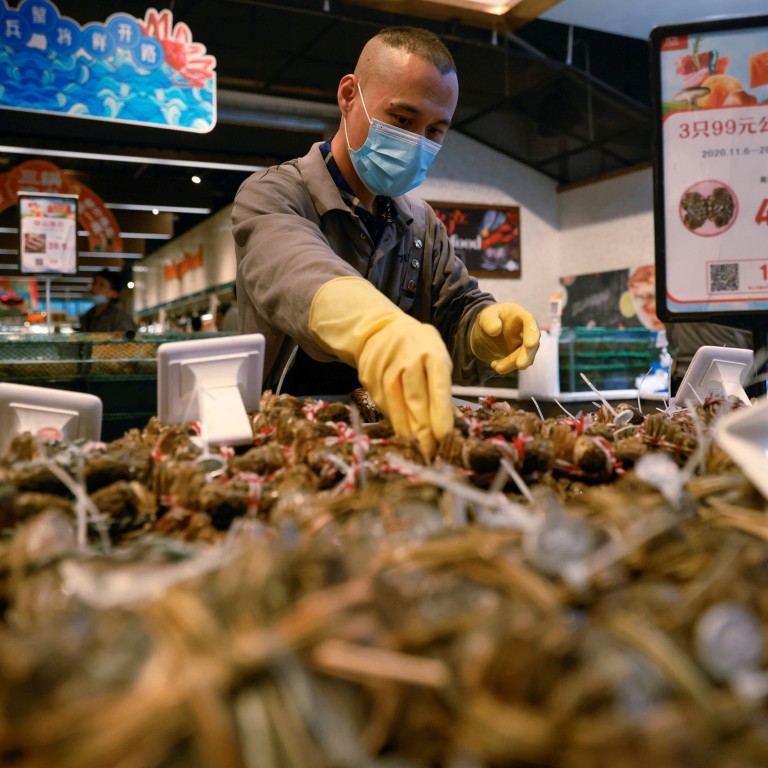
China inflation: factory-gate prices surge by most in over three years
- The producer price index (PPI), a gauge of industrial profitability, rose 6.8 per cent in April from a year earlier, the National Bureau of Statistics said
- The consumer price index (CPI) rose 0.9 per cent from a year earlier, compared with a 0.4 per cent rise in March
China’s factory gate prices rose at the fastest rate in three and a half years in April, official data showed on Tuesday, as the world’s second-largest economy continued to gather momentum following record-setting growth in the first quarter.
The consumer price index (CPI), however, rose a modest 0.9 per cent.
Investors globally are increasingly worried that coronavirus pandemic-driven stimulus measures could spark a rapid rise in inflation and force central banks to raise interest rates and take other tightening measures, potentially holding back economic recovery.
“Price surges have spread to midstream products, and will continue to affect midstream and downstream merchandise, driving an increase in costs for the whole society,” said Hu Yanhong, an analyst at Yingda Securities.
“It could become an obstacle to the economic advances.”
Chinese authorities have repeatedly said they will avoid sudden policy shifts that could derail the recovery, but are slowly normalising policy and clamping down on property speculation in particular.
The sharp jump in producer prices included an 85.8 per cent surge in the oil and natural gas extraction sector from a year ago, while the melting and processing of ferrous metals rose 30 per cent, said Dong Lijuan, senior NBS statistician.
Still, PPI rose 0.9 per cent in April from a month ago, easing from a 1.6 per cent gain the previous month.
Many economists expect China’s GDP growth to exceed 8 per cent in 2021, although some warn that continuing global supply chain disruptions and higher comparison bases will sap some momentum in coming quarters.
The 0.9 per cent CPI increase in April from a year earlier was up on a 0.4 per cent rise in March, driven mostly by gains in non-food prices. However, it missed analysts’ expectations for a 1.0 per cent rise.
Food inflation remained weak. Prices dropped by 0.7 per cent from a year earlier, unchanged from the previous month, weighed by falling pork prices.
Non-food inflation accelerated to 1.3 per cent year on year in April from 0.7 per cent increase in the previous month, as airfares and retail oil prices surged.
Core inflation, which excludes volatile energy and food prices, rose 0.7 per cent in April, up from 0.3 per cent in March.
Looking ahead, supply-side disruptions may persist for a while longer, keeping producer price inflation elevated in the near-term
Despite rising pressure from imported global inflation, China’s full-year CPI is likely to be significantly below the official target of around 3 per cent, deputy director at NBS Sheng Laiyun, said on Friday in an interview with Economics Daily.
Sheng attributed China’s likely muted inflation to currently slow core inflation, economic fundamentals where supply has outstripped demand, relatively restrained macropolicy support, recovering pork supply and a limited pass-through effect from PPI to CPI.
“Producer price inflation was the strongest since October 2017 last month, as upstream price pressures remained significant due to supply constraints. This is feeding through to a rebound in consumer price inflation, though with the latter still relatively subdued and upstream price pressures likely to be mostly transient, we still doubt that inflation is about to become a key driver of [People’s Bank of China] policy,” Julian Evans-Pritchard, senior China economist at Capital Economics, said in a statement.
“Looking ahead, supply-side disruptions may persist for a while longer, keeping producer price inflation elevated in the near-term. Alongside a tightening labour market, this looks set to drive a further rebound in consumer price inflation – most likely to around 2 per cent by the end of quarter three.
“That said, we still expect much of the recent surge in upstream price pressure to prove transit, with industrial metal prices likely to drop back later this year as a tighter policy stance weighs on construction activity. As such, we don’t think inflation will rise to the point where it triggers a major policy shift by the [People’s Bank of China].”

